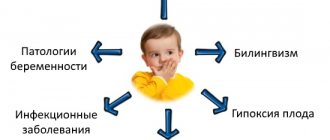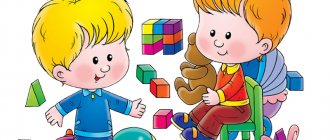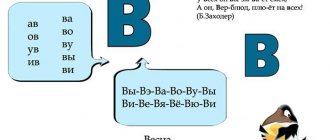Features of child speech development.
The development of a child’s speech is certainly related to the development of his brain. The human brain develops from bottom to top and from right to left.
The first to appear is “stem speech” (the brain stem responds). This includes crying, screaming, humming, grunting, and babbling. These are the child’s first ways of communicating with the outside world.
The brain stem is very important for development. To help it function successfully, it is necessary to follow a daily routine, periods of sleep and wakefulness, and walk in the fresh air.
Further, as the brain develops, “right-hemisphere speech” (from approximately 1 year to 2 years). This includes onomatopoeia and echolalia. Echolalia is when a child repeats a word after an adult, but does not understand its meaning; the meaning of this word has not been formed. Closer to the age of 2, “left-hemisphere speech” begins to form.
It is in the left hemisphere that the fusion of word-image, word-action and word-description occurs and the child develops phrasal speech. This transition from the right hemisphere to the left is very important.
The right hemisphere “gives up” speech and begins to engage in the following functions. If a child by the age of 2 does not have a phrase, much less words, then you should pay attention to this.
The correction path started earlier will give more results.
Novikova-Ivantsova technique
The method of forming a language system (MFLS), developed by T. N. Novikova-Ivantsova, is applicable not only for all types of alalia, but for cerebral palsy and autism spectrum disorders. It is also suitable for children who have undergone cochlear implantation and have difficulties with the syllable structure of speech, the tempo and rhythm of speech, and the articulation of sounds.
The methodology is based on the ontogenetic principle of speech: from shouting to humming, from humming to babbling and speech. The initial stage of speech development is a cry, with its help small children aged from birth to 2-3 months react to any discomfort: pain, thirst, hunger. Healthy children scream loudly and loudly, with a short inhalation and a long exhalation. Babies with central nervous system pathologies, on the contrary, scream either too loudly or too quietly, and their cry sounds like sobbing. In severe cases, there is no cry at all.
Humming appears at the age of 3-5 months. Healthy children begin to chant, draw out vowel sounds, gradually adding consonants to them. Thus, the baby’s speech organs master the articulation of sounds. Humming has an intonation coloring, because with its help the child reacts to the speech of the parents.
Babies start babbling between 5 and 9 months of age. The child is able to repeat simple syllables of vowels and consonants many times, he listens carefully to spoken speech, and the duration of exhalation develops. Normally, by 10-12 months he can pronounce simple babbling words like “mama”, “baba”. One-year-old children should have about 10 babbling words in their active vocabulary. Gradually, by the age of two, children master phrasal speech.
The stages described are the foundation of speech development. If some stage “falls out,” for example, due to a serious illness, then it must be restored, otherwise the child will never speak. The Novikova-Ivantsova technique helps children go through the stages of humming and babbling again, master and improve the syllabic structure of words, and learn to pronounce two-syllable words and simple phrases.
MFYS classes are aimed at developing the speech apparatus and speech-auditory perception. At the initial stage, exercises on rhythm and the separation of non-speech and speech sounds are used. The correctional stage involves the development of complex non-verbal material, which involves fine motor skills and visual memory, so mastering the syllabic structure of a word occurs faster and better.
The key instrument that triggers the speech mechanism is music. It has been proven that children to whom their mothers sang songs in their native language in early childhood, as a rule, do not have problems with speech development. Each lesson in the Novikova-Ivantsova method corresponds to certain melodies.
Prerequisites for the emergence of speech.
- Subject-based practical environment. The child is surrounded by a developing environment and understands HIMSELF that sand can be poured into a bucket, rings can be put on the base of the pyramid, and objects can be inserted into the holes of the sorter.
- Basic identification. Understanding your body map: shows body parts on yourself, your mother, a toy, a picture.
- Emotional sphere - understands the basic emotions of happy and sad.
- Various forms of communication between a child and an adult.
- Motivation is the presence of a need for speech. Communicate with questions, not declarative sentences.
- Concentration of attention. Attract the child’s attention with the words: “look”, “look”, “see”.
- Working with memory capacity. It is necessary to increase it gradually.
- Induce speech automatisms (yes - no, many - few, yes - no). Children perceive emotions well at the level of intonation.
The first level of speech development is characterized by
- Complete or partial absence of speech. As a rule, children communicate with others using “babble” words, incomplete, “babble” sentences, reinforcing statements with gestures and facial expressions. Children's active vocabulary consists of a small number of onomatopoeias and sound complexes. Children often replace the names of actions with the names of objects and vice versa (for example, to open - “drev” (door), play with a ball - just “ball”, airplane - “fly”);
- Lack of phrasal speech. Children use one-word sentences;
- Blurred sound pronunciation, unclear articulation, inability to pronounce many sounds;
- Difficulties in reproducing the syllabic structure of a word. Most often, children reproduce monosyllabic sound complexes (cubes - “ku”), or repeated syllables (“bi-bi”, “tu-tu”). Sound word analysis is not available for children;
- Lack of understanding of the meaning of grammatical changes to a word. For example, children do not distinguish between the singular and plural forms of a noun, the past tense of a verb, an adjective, masculine and feminine forms, and do not understand the meaning of prepositions.
Method of starting speech.
This method of starting speech is suitable for a normotypical child (no diagnosis, understands spoken speech; hearing, vision, intellectual abilities are normal).
Why should you give up gadgets?
The technique of starting a speech starts with the simplest, and for some, “difficult”. We remove gadgets and musical toys as much as possible. Why?
- Firstly, the child does not see the correct articulation of the speech apparatus. Cartoon characters open their mouths automatically.
- Secondly, constantly changing the picture reduces the child’s concentration. It will be difficult for him to study. TV becomes dopamine for a child.
- Thirdly, the skill of listening is lost. We may not notice this (but this especially affects children) speech broadcast from TV and live speech is very different in perception. Speech from gadgets has a truncated sound. We ourselves cannot grasp it. As a result, the brain receives distorted, truncated information.
Wait. Let the child speak, and then there will be cartoons.
What to pay attention to when starting a speech?
- Development of gross motor skills. It is gross motor skills that give impetus and launch speech. The brain stem is responsible for gross motor skills and it is much more difficult to work on. “Developers” won’t help here. Important: routine, proper sleep, nutrition, movement, walks. As your child develops gross motor skills, study a body map. The child must know where his hands, feet, knees, and so on are. Offer to raise your arms and legs to the side, jump, buy a balance bike, scooter, bicycle, play with a ball, swim.
- Development of fine motor skills - works on understanding speech, syllable structure, diction. There are many options for developing fine motor skills. Playing with sand, modeling with dough or plasticine, stringing beads, playing with stones, su-jok, massages, finger games, sensory boxes, drawing on semolina.
- Articulation and breathing exercises. Choose a task based on your child’s capabilities and interests. An excellent training for the articulation of the speech apparatus would be chewing solid food (apple, carrot). Since a person pronounces all sounds and words while exhaling, the development of speech breathing is also of enormous importance.
- Speech exercises. For example: visual-rhythmic series. The child is asked to continue the given sequence, voicing it.
- Intellectual exercises. Without new knowledge, it is impossible to activate the left hemisphere, which is necessary for coherent speech.
Watch. Which of these five directions have a drawdown. Pay special attention to the lagging direction.
Do not start a conversation with your child with the words “say” or “repeat.” This can cause speech negativism and a complete refusal to communicate.
Your task, as an adult, is to build a dialogue with the child. How do we do this? Let's start asking questions.
- Do you want to go outside? (not - we’re going outside)
- Will you eat soup?
- Will you eat soup or porridge? (they put what they want first).
Let the child think, be silent, suggest, give a reaction. Don't rush him, don't answer for him. repeatedly. He must feel that he is a participant in the conversation.
Method of starting speech - calling out the first words.
- Speech automatisms: yes - no. Find something to which the child responds emotionally. Let this thing, the toy, be the basis of the “dialogue”.
- Onomatopoeia (up to 2.5 years) and sound gesture (after 2.5 years). With a sound gesture, we verbalize the action. For example: the ball fell bang. We take the ball and at every contact with the floor or table we say “bang.” Thus speech is subordinated to action.
- Verb components. (Give it, na).
- Nouns. (Who is this? What is this?)
- Adjectives (description). The simplest ones are big and small.
Starting these few words will provide the basis for further work, expanding your vocabulary.
Don't force things. There is no need to evoke both speech automatisms and verbs with a noun in 5 minutes of class. One direction of work is selected. The child must live through this speech moment and become aware of it. Only then will there be a result. The words “yes - no” can be practiced over the course of several days, or over the course of a month. Everything is individual.
Formation of phrasal speech in preschoolers with developmental disabilities article on correctional pedagogy
Formation of phrasal speech in children with mental retardation.
According to the model of A.A. Leontief's process of generating a speech utterance includes five successive, interconnected stages (or “phases”).
-motive, i.e. the need to express, convey certain information;
- the idea, what needs to be said is determined;
— the stage of internal programming is the process of constructing a certain semantic scheme, on the basis of which a speech utterance is generated;
- stage of lexico-grammatical development of the utterance
- the stage of its implementation “in the external plane” (in external speech).
Let us consider the formation of a phrase in ontogenesis. We know that with normal speech development at 1.3-1.8 years, individual amorphous words act as sentences. From 1.8 to 1.10 years, the child combines 2 amorphous words into one sentence. In 2.6–3 years, a complex sentence develops. From 3 to 4 years - the development of complex and complex sentences. And from 4 to 6, the child tries to construct sentences with allied words, but has difficulty constructing subordinate clauses.
In preschool children with motor alalia, phrase construction proceeds somewhat differently. If a child with motor alalia independently forms a phrase (approximately 4.5 - 5 years), then this is a short simple sentence that may contain:
- violation of word order (tendency to place the predicate at the end of the sentence);
- missing words;
- lack of prepositions and conjunctions (“Matik katatya ani” (The boy is sledding), “Nadei papas oni” (Put boots on his feet) or their incorrect use;
- limitation of the set of syntactic connections and their disorder.
Children with motor alalia predominantly use one-part sentences, two-part sentences consisting of a demonstrative pronoun and a noun in the nominative case (This is a cat), sentences consisting of two nouns (subject - object) or sentences in the form of a word with a gesture.
Features of speech therapy work in the formation of phrasal speech in preschool children with motor alalia
During the spontaneous development of alalik children, their speech changes, but this development differs sharply from the development of normally speaking children in terms of quantitative and qualitative indicators: there is a slowdown in the rate of development, only individual speech acts and individual linguistic signs accumulate, i.e. they do not a system is created. Therefore, in the process of their development, alaliks only move from one level of speech underdevelopment to another, remaining essentially non-speaking (or poorly speaking) children. (It is known that alalik can learn up to 200 or more words, and can pronounce them correctly, but remain a child without speech.)
It is obvious that the nature of the defect has placed some obstacles on the path of the spontaneous development of alalik that do not allow him to independently, without outside influence, enter the only necessary path of system formation - the ontogenetic development of speech in normal children.
As practice shows, with complex (medical and pedagogical) influence, the speech of alaliks significantly improves, since for them the ontogenetic formation of speech opens up prospects for its development along a functional path, in which learning, i.e., the pedagogical (speech therapy) link of the complex influence, takes on the leading role .
We see the general goal of speech therapy work for motor alalia in the creation of a speech base in alaliks that allows their speech to further develop spontaneously and form a system.
The most justified model for creating such a base, it seems to us, is the path of speech development in ontogenesis. However, when working with alaliks, it is not possible to blindly copy the normal path of speech development with its particulars and details. The task is to take into account the basic patterns of this path, to focus on the key links in the development of the system.
Speech therapy work with such children is usually built in stages. So Heikinei O.A. identifies the following stages of correctional work:
Stage 1 - education of speech activity, formation of passive and active vocabulary;
Stage 2 - the formation of phrasal speech against the backdrop of increasing complexity of the vocabulary and phrase structure (work is underway on the distribution of sentences, their grammatical design, on dialogue and a descriptive story);
Stage 3 - development of coherent speech and automation of grammatical structures. This stage was followed by such generally recognized speech therapists as B.M. Grinshpun, S.N. Shakhovskaya et al.
The formation of phrasal speech plays a leading role when working with motor skills.
The main task of the initial stages of speech therapy treatment for alalia will be the creation of stimuli, “trigger mechanisms” that should ensure the development of the speech of alalia and their assimilation of the language system.
At the first stages of speech therapy, it is usually recommended to begin working on the pronunciation and accumulation of words denoting the names of objects.
After I have accumulated a certain subject vocabulary (1st grade syllable structure, or 3rd grade syllable structure), I try to combine these words into simple rhymes. Using the technique of graphomotor stimulation of speech, when every sound, syllable, word is connected to an action. We draw at the same time with both hands on a vertical surface and at the same time say: Lump, lump, another lump, the whole woman has come out.
Also, by playing out the situation with the characters (grandfather, woman, Tom), and then visual modeling using a computer, we put words-objects into a simple verse. Again we connect the action with the word, lay out the figures and say a word for each figure: the woman is at home, the grandfather is at home, Tom is not at home, where is Tom? She's at the house.
The use of mnemonic tables and visual cues becomes necessary in the work of forming phrases among alaliks. Moreover, not only images of objects help the child, but I also draw circles-“buttons”, by clicking on each of them, we pronounce a word. We see that again speech is combined with action: this is a poppy, this is a cat, this is a ball, this is juice, this is you, this is me, this is my mother. Thus, we expand the phrase to 3 or more words.
At the same time, as soon as we have learned the words mom, dad, baba, we introduce the predicate. Two-word sentences with a verb either in the 1st person present tense based on actions with objects (I am carrying, I am walking, etc.) or in an incentive form. First, this action is in the imperative mood. We ask the child, for example, to call mom, dad, etc.: mom go, dad go. As part of the lesson, you can use computer games from the Mersibo website, a Pervolov flash drive for starting the speech of non-speaking children.
Then we expand the phrase by including secondary members - nouns in the forms of indirect cases, often with the accusative singular case model (Anya, my lalya).
After working out the above models, you can move on to forming models from two main members: the subject and the predicate. The child must express a judgment about the actions of another person (or animal), a phrase with a predicate in the 3rd person present tense. (Zaya is sitting, Misha is sleeping, etc.). We teach you to answer the question: What is Misha doing?
This work should first be carried out on the basis of alalik’s observations of the actions of those around him (children in the group or parents) and only then on the basis of didactic material: toys, pictures, etc.
At this stage, it is necessary to carry out work on differentiating the 1st and 3rd person forms of the verb (I go - goes), as well as on differentiating the forms of the nominative and oblique cases.
As a result, the child forms another type of sentence - complete, two-part.
Then we expand this phrase to 3 words. The “Living Phrases” technique is very effective in working with alalik children. Videos with various actions help to better understand the situation and see who is doing what. After watching the video, we begin to compose a phrase. The pictures are arranged in three piles: people, actions, objects, which are covered on top with a blank piece of paper. First, we open the first pictures and ask: Who is this?, pointing to the video, the child posts the picture Aunt. What is aunt doing? We open the second group of pictures, the child chooses an action: washes. What is aunty washing? - ball. We say the whole sentence: Aunt is washing the ball.
That. We accumulate a certain base in the construction of a phrase. The system being built makes it possible to spontaneously increase the vocabulary of objects and the vocabulary of actions in the future and combine them into a phrase, further expanding it.
The formation of phrasal speech at the second stage of speech therapy work is carried out in the following directions:
- Work on the grammatical structure of speech;
- Work on sentence structure;
- Work on its intonation design.
The use of Russian folk tales and Russian folklore in work helps to develop intonation expressiveness of speech in children and forms dialogical speech when dramatizing a fairy tale. We gradually move on to monologue coherent speech. Based on the child’s capabilities, the fairy tale can be simplified, composed from those sentences that the child knows, and the simplified text of the fairy tale can be memorized. S. Batyaeva (“Album on Speech Development”) in the fairy tale “Turnip” gives an option: Baba, go pull a turnip, etc. Reproducing a memorized text quickly becomes accessible to the child and gives him great pleasure.
Modeling a fairy tale also helps to present it consistently without disturbing the composition of the work.
We examined the initial stage of phrase formation in non-speaking children.
T.O., the created base makes it possible to develop and distribute sentences, form the structure of a phrase in preschoolers with motor alalia from elementary to more complex.
Build-up technique when starting speech.
This method of starting speech involves building on the child’s existing syllable. For example: there is a syllable “MA”. Your task is to find words with the syllable “MA”. Writing is not taken into account. It is important how the word is pronounced. (mom, car, raspberry, mo(a)loko). The child says: MA, you continue: ...TIRES.
Create a situation of success.
It is very important. Let him pronounce it incorrectly. In response, you repeat the word correctly and praise. Preschoolers should have a desire to enter into a dialogue with you.
In order for a child to form a word, it is necessary that there are about fifty images of it in his head. For example: car. Car rides. You have a red car. What a big car it is drawn. The car has wheels and a steering wheel. Today we are going to the dacha by car. The ambulance honks. Children should study this subject from all sides. Color, shape, size, what it’s for, how to use it. We don’t just say the same word, we reinforce it all with pictures, toys, and a story.
Don't overload with information. There should be few words, but to the point. The child must grasp the essence.
Correct: Look. Car rides.
Incorrect: Oh, son. Seryozha. Look how many cars have gone. And red, and blue, and yellow. Where are they all going?
The child will not be able to grasp anything from such a flow of information. Imagine that you started learning a foreign language and they played a song at a fast tempo with a lot of words that needs to be translated. Difficult. Likewise, it is difficult for a child to isolate the necessary information.






